常见的ORACLE语句
基本

--新建表:
create table table1( id varchar(300) primary key, name varchar(200) not null); --插入数据
insert into table1 (id,name) values ('aa','bb'); --更新数据
update table1 set id = 'bb' where id='cc'; --删除数据
delete from table1 where id ='cc'; --删除表
drop table table1; --修改表名:
alter table table1 rename to table2; --表数据复制:
insert into table1 (select * from table2); --复制表结构:
create table table1 select * from table2 where 1>1; --复制表结构和数据:
create table table1 select * from table2; --复制指定字段:
create table table1 as select id, name from table2 where 1>1; --条件查询:
select id,name (case gender when 0 then '男' when 1 then ‘女’ end ) gender from table1

数学函数

--绝对值:abs()
select abs(-2) value from dual; --(2) --取整函数(大):ceil()
select ceil(-2.001) value from dual; --(-2) --取整函数(小):floor()
select floor(-2.001) value from dual; --(-3) --取整函数(截取):trunc()
select trunc(-2.001) value from dual; -- (-2) --四舍五入:round()
select round(1.234564,4) value from dual; --(1.2346) --取平方:Power(m,n)
select power(4,2) value from dual; --(16) --取平方根:SQRT()
select sqrt(16) value from dual; --(4) --取随机数:dbms_random(minvalue,maxvalue)
select dbms_random.value() from dual; (默认是0到1之间)
select dbms_random.value(2,4) value from dual; (2-4之间随机数) --取符号:Sign()
select sign(-3) value from dual; --(-1)
select sign(3) value from dual; --(1) --取集合的最大值:greatest(value)
select greatest(-1,3,5,7,9) value from dual; --(9) --取集合的最小值:least(value)
select least(-1,3,5,7,9) value from dual; --(-1) --处理Null值:nvl(空值,代替值)
select nvl(null,10) value from dual; --(10)
select nvl(score,10) score from student;

rownum相关

--rownum小于某个数时可以直接作为查询条件(注意oracle不支持select top)
select * from student where rownum <3; --查询rownum大于某个数值,需要使用子查询,并且rownum需要有别名
select * from(select rownum rn ,id,name from student) where rn>2;
select * from (select rownum rn, student.* from student) where rn >3; --区间查询
select * from (select rownum rn, student.* from student) where rn >3 and rn<6; --排序+前n条
select * from (select rownum rn, t.* from ( select d.* from DJDRUVER d order by drivernumber)t )p where p.rn<10; --排序+区间查询1
select * from (select rownum rn, t.* from ( select d.* from DJDRIVER d order by DJDRIVER_DRIVERTIMES)t )p where p.rn<9 and p.rn>6; --排序+区间查询2
select * from (select rownum rn, t.* from ( select d.* from DJDRIVER d order by DJDRIVER_DRIVERTIMES)t where rownum<9 )p where p.rn>6;--效率远高于方式一

分页查询
(假设每页显示10条)
不包含排序:

--效率低 select * from (select rownum rn, d.* from DJDRIVER d )p where p.rn<=20 and p.rn>=10;
select * from (select rownum rn, d.* from DJDRIVER d )p where p.rn between 10 and 20; --效率高 select * from (select rownum rn, d.* from DJDRIVER d where rownum<=20 )p where p.rn>=10;

包含排序:

--排序+区间查询1(效率低)
select * from (select rownum rn, t.* from ( select d.* from DJDRIVER d order by DJDRIVER_DRIVERTIMES)t )p where p.rn<=20 and p.rn>=10;
select * from (select rownum rn, t.* from ( select d.* from DJDRIVER d order by DJDRIVER_DRIVERTIMES)t )p where p.rn between 10 and 20; --排序+区间查询2(效率高)
select * from (select rownum rn, t.* from ( select d.* from DJDRIVER d order by DJDRIVER_DRIVERTIMES)t where rownum<=20 )p where p.rn>=10;

时间处理
1. to_char和to_date基本使用

--日期
--年 yyyy yyy yy year
--月 month mm mon month
--日+星期 dd ddd(一年中第几天) dy day
--小时 hh hh24
--分 mi
--秒 ss

eg1:

select to_char(sysdate,'yyyy-mm-dd hh24:mi:ss')currenttime,
to_char(sysdate,'yyyy') year,
to_char(sysdate,'mm') month,
to_char(sysdate,'dd') day,
to_char(sysdate,'day') week,
to_char(sysdate,'hh24')hour,
to_char(sysdate,'mi') minute,
to_char(sysdate,'ss') second
from dual;


eg2:

select to_date('2009-07-04 05:02:01','yyyy-mm-dd hh24:mi:ss')currenttime,
to_char(to_date('2009-07-04 05:02:01','yyyy-mm-dd hh24:mi:ss'),'yyyy')year,
to_char(to_date('2009-07-04 05:02:01','yyyy-mm-dd hh24:mi:ss'),'mm')month,
to_char(to_date('2009-07-04 05:02:01','yyyy-mm-dd hh24:mi:ss'),'dd') day,
to_char(to_date('2009-07-04 05:02:01','yyyy-mm-dd hh24:mi:ss'),'day') week,
to_char(to_date('2009-07-04 05:02:01','yyyy-mm-dd hh24:mi:ss'),'day','NLS_DATE_LANGUAGE=American') week, --设置语言
to_char(to_date('2009-07-04 05:02:01','yyyy-mm-dd hh24:mi:ss'),'hh24')hour,
to_char(to_date('2009-07-04 05:02:01','yyyy-mm-dd hh24:mi:ss'),'mi') minute,
to_char(to_date('2009-07-04 05:02:01','yyyy-mm-dd hh24:mi:ss'),'ss') second
from dual;


2)months_between
select months_between(to_date('03-31-2014','MM-DD-YYYY'),to_date('12-31-2013','MM-DD-YYYY')) "MONTHS"
FROM DUAL;

3)next_day
select sysdate today, next_day(sysdate,6) nextweek from dual;

4)时间区间
eg:
select cardid, borrowdate from borrow where to_date(borrowdate,'yyyy-mm-dd hh24:mi:ss') between
to_date('2014-02-01 00:00:00','yyyy-mm-dd hh24:mi:ss') and
to_date('2014-05-01 00:00:00','yyyy-mm-dd hh24:mi:ss');
5)interval

select to_char(sysdate,'yyyy-mm-dd hh24:mi:ss') currenttime,
to_char(sysdate - interval '7' year,'yyyy-mm-dd hh24:mi:ss') intervalyear,
to_char(sysdate - interval '7' month,'yyyy-mm-dd hh24:mi:ss') intervalMonth,
to_char(sysdate - interval '7' day,'yyyy-mm-dd hh24:mi:ss') intervalday,
to_char(sysdate - interval '7' hour,'yyyy-mm-dd hh24:mi:ss') intervalHour,
to_char(sysdate - interval '7' minute,'yyyy-mm-dd hh24:mi:ss') intervalMinute,
to_char(sysdate - interval '7' second,'yyyy-mm-dd hh24:mi:ss') intervalSecond
from dual;


6)add_months
select add_months(sysdate,12) newtime from dual;
7)extract
select extract(month from sysdate) "This Month",
extract(year from add_months(sysdate,36)) " Years" from dual;

字符函数

--字符函数
select substr('abcdefg',1,5)substr, --字符串截取
instr('abcdefg','bc') instr, --查找子串 'Hello'||'World' concat, --连接 trim(' wish ') trim, --去前后空格
rtrim('wish ') rtrim, --去后面空格
ltrim(' wish') ltrim, --去前面空格 trim(leading 'w' from 'wish') deleteprefix, --去前缀
trim(trailing 'h' from 'wish') deletetrailing, --去后缀
trim('w' from 'wish') trim1, ascii('A') A1,
ascii('a') A2, --ascii(转换为对应的十进制数)
chr(65) C1,
chr(97) C2, --chr(十进制转对应字符) length('abcdefg') len, --length lower('WISH')lower,
upper('wish')upper,
initcap('wish')initcap, --大小写变换 replace('wish1','1','youhappy') replace, --替换 translate('wish1','1','y')translate, --转换,对应一位(前面的位数大于等于后面的位数)
translate('wish1','sh1','hy')translate1, concat('11','22') concat --连接 from dual;


to_number

--to_number(expr)
--to_number(expr,format)
--to_number(expr,format,'nls-param') select to_number('0123')number1, --converts a string to number
trunc(to_number('0123.123'),2) number2,
to_number('120.11','999.99') number3,
to_number('0a','xx') number4, --converts a hex number to decimal
to_number(100000,'xxxxxx') number5
from dual;


聚合函数
student表如下:
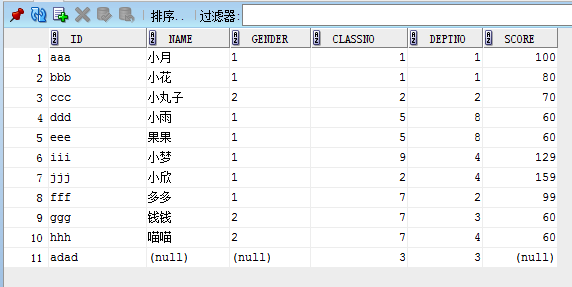
count:
--count (distinct|all)
select count(1) as count from student;--效率最高
select count(*) as count from student;
select count(distinct score) from student;
语句1结果:11
avg
--avg (distinct|all)
select avg(score) score from student;
select avg(distinct score) from student;
select classno,avg(score) score from student group by classno;
语句3输出结果:
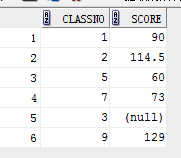
max
--max (distinct|all)
select max(score) from student;
select classno, max(score) score from student group by classno;
min
--min (distinct|all)
select min(score) from student;
select classno, min(score) score from student group by classno;
stddev(standard deviation)标准差
--stddev
select stddev(score) from student;
select classno, stddev(score) score from student group by classno;
sum
--sum
select sum(score) from student;
select classno, sum(score) score from student group by classno;
median--中位数
--median
select median(score) from student;
select classno, median(score) score from student group by classno;
案例1--学生选课
1. 创建表 stu(学生表),course(课程表),选课表(s_c)

--创建表 create table STU
(
id NUMBER not null,
name VARCHAR2(255)
) ; create table COURSE
(
id NUMBER not null,
coursename VARCHAR2(255)
) ; create table S_C
(
sid NUMBER,
cid NUMBER,
score NUMBER
);

2.插入数据

--插入数据
Insert into STU (ID,NAME) values (1,'wish');
Insert into STU (ID,NAME) values (2,'rain');
Insert into STU (ID,NAME) values (3,'july');
Insert into STU (ID,NAME) values (4,'joey'); Insert into COURSE (ID,COURSENAME) values (1,'math');
Insert into COURSE (ID,COURSENAME) values (2,'english');
Insert into COURSE (ID,COURSENAME) values (3,'Japanese');
Insert into COURSE (ID,COURSENAME) values (4,'chinese'); Insert into S_C (SID,CID,SCORE) values (1,1,80);
Insert into S_C (SID,CID,SCORE) values (1,2,90);
Insert into S_C (SID,CID,SCORE) values (2,4,100);
Insert into S_C (SID,CID,SCORE) values (4,4,90);
Insert into S_C (SID,CID,SCORE) values (4,1,100);
Insert into S_C (SID,CID,SCORE) values (4,3,80);
Insert into S_C (SID,CID,SCORE) values (4,2,80);
Insert into S_C (SID,CID,SCORE) values (2,1,90);
Insert into S_C (SID,CID,SCORE) values (2,4,100);
Insert into S_C (SID,CID,SCORE) values (3,1,60);

3.查询学生选课情况
with vt as
(select s.id,s.name,c.coursename,sc.score from stu s, course c, s_c sc where s.id=sc.sid and c.id=sc.cid)
select * from vt order by id;
结果:
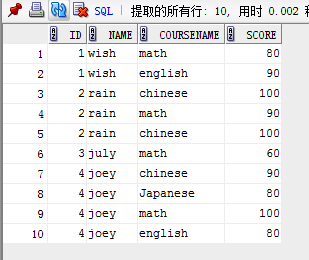
案例2--图书馆借阅
1.创建表: 图书(book),读者(reader),借阅(borrow)

--创建表 book
create table book(
bookId varchar2(30), --图书总编号
sortid varchar2(30), --分类号
bookname varchar2(100), --书名
author varchar2(30), --作者
publisher varchar2(100),--出版单位
price number(6,2) --价格
); --创建表 reader
create table reader (
cardId varchar2(30), --借书证号
org varchar2(100), --单位
name varchar2(100), --姓名
gender varchar2(2), --性别
title varchar2(30), --职称
address varchar2(100) --地址
); --创建表 borrow
create table borrow(
cardId varchar2(30), --借书证号
bookId varchar2(30), --图书总编号
borrowDate varchar2(30) --借阅时间
);

2.插入数据

--插入数据-book
insert into book (bookId,sortid,bookname,author,publisher,price)
values ('aaa','a1','gone with the wind','CA','renmin','103'); insert into book (bookId,sortid,bookname,author,publisher,price)
values ('bbb','a2','the little prince','CB','jixie','30'); insert into book (bookId,sortid,bookname,author,publisher,price)
values ('ccc','a3','the ordinary world','CC','renmin','130'); insert into book (bookId,sortid,bookname,author,publisher,price)
values ('ddd','a4','the little women','CA','dianzi','110'); --插入数据-reader
insert into reader(cardid, org, name,gender, title, address)
values ('xxx','A','wish','1','student','bupt'); insert into reader(cardid, org, name,gender, title, address)
values ('uuu','A','luna','1','student','bupt'); insert into reader(cardid, org, name,gender, title, address)
values ('vvv','B','harry','1','student','bupt'); insert into reader(cardid, org, name,gender, title, address)
values ('www','C','chander','2','professor','bupt'); insert into reader(cardid, org, name,gender, title, address)
values ('yyy','A','joey','2','student','bupt'); insert into reader(cardid, org, name,gender, title, address)
values ('zzz','B','richard','2','student','bupt'); insert into reader(cardid, org, name,gender, title, address)
values ('OOO','A','micheal','2','student','bupt'); insert into reader(cardid, org, name,gender, title, address)
values ('ppp','A','richal','2','student','bupt'); insert into reader(cardid, org, name,gender, title, address)
values ('abp','A','michal','2','student','bupt'); insert into reader(cardid, org, name,gender, title, address)
values ('ccp','A','mike','2','student','bupt'); --插入数据-borrow
insert into borrow(cardid,bookid,borrowdate) values('xxx','aaa','2014-4-29');
insert into borrow(cardid,bookid,borrowdate) values('xxx','bbb','2014-4-29');
insert into borrow(cardid,bookid,borrowdate) values('xxx','ccc','2014-4-28');
insert into borrow(cardid,bookid,borrowdate) values('yyy','ccc','2014-4-28');
insert into borrow(cardid,bookid,borrowdate) values('yyy','ddd','2014-4-27');
insert into borrow(cardid,bookid,borrowdate) values('yyy','aaa','2014-4-27');
insert into borrow(cardid,bookid,borrowdate) values('zzz','bbb','2014-4-28');
insert into borrow(cardid,bookid,borrowdate) values('zzz','ddd','2014-4-27');
insert into borrow(cardid,bookid,borrowdate) values('zzz','aaa','2014-4-27');
insert into borrow(cardid,bookid,borrowdate) values('uuu','bbb','2014-4-28');
insert into borrow(cardid,bookid,borrowdate) values('uuu','ddd','2014-4-27');
insert into borrow(cardid,bookid,borrowdate) values('uuu','aaa','2014-4-27');
insert into borrow(cardid,bookid,borrowdate) values('uuu','ccc','2014-4-26');
insert into borrow(cardid,bookid,borrowdate) values('vvv','bbb','2014-4-28');
insert into borrow(cardid,bookid,borrowdate) values('vvv','ddd','2014-4-27');
insert into borrow(cardid,bookid,borrowdate) values('www','aaa','2014-4-27');
insert into borrow(cardid,bookid,borrowdate) values('www','ccc','2014-4-26');

表信息如下:
book------> reader-------> borrow

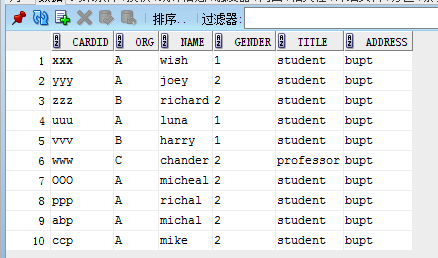
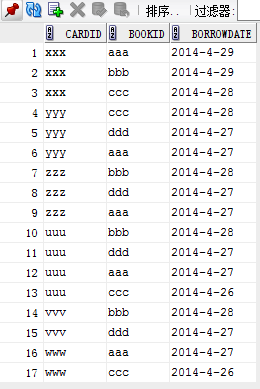
3. 查询A单位借阅图书的读者人数和人员详细信息
人数:
with vt1 as
(select cardid from reader where reader.org='A')
select count(1) from vt1 where exists (select cardid from borrow where borrow.cardid=vt1.cardid);

详细信息:
with vt1 as
(select cardid,name,org from reader where reader.org='A')
select cardid,name,org from vt1 where exists (select cardid from borrow where borrow.cardid=vt1.cardid);
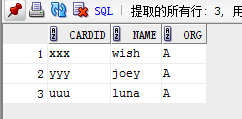
4.查询借书证号尾字符为'p'的读者
select cardid, name, org from reader where cardid like '%p';
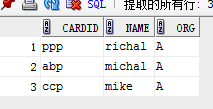
5. 查询名字以m开头的女性读者,‘1’显示为女,‘2’显示为男
select cardid, name, org,
case when gender='1' then '女' when gender='2' then '男' else '其他' end gender
from reader where name like 'm%';
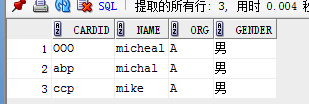
6. 2014年2-4月借过书的读者
1)查询满足条件的读者(仅包含cardid)--未去重
方式一:
select cardid, borrowdate from borrow where to_char(to_date(borrowdate,'yyyy-mm-dd'),'yyyy')='2014'
and to_char(to_date(borrowdate,'yyyy-mm-dd'),'mm')>='02'
and to_char(to_date(borrowdate,'yyyy-mm-dd'),'mm')<='04';
方式二:
select cardid, borrowdate from borrow where to_char(to_date(borrowdate,'yyyy-mm-dd'),'yyyy')='2014' --查询
and to_char(to_date(borrowdate,'yyyy-mm-dd'),'yyyy-mm')>='2014-02'
and to_char(to_date(borrowdate,'yyyy-mm-dd'),'yyyy-mm')<='2014-04';
方式三:
select cardid, borrowdate from borrow where to_date(borrowdate,'yyyy-mm-dd hh24:mi:ss') between
to_date('2014-02-01 00:00:00','yyyy-mm-dd hh24:mi:ss') and
to_date('2014-05-01 00:00:00','yyyy-mm-dd hh24:mi:ss');
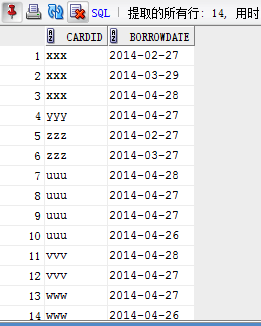
2) 查询+去重
select distinct cardid from borrow where to_char(to_date(borrowdate,'yyyy-mm-dd'),'yyyy')='2014' --查询+去重
and to_char(to_date(borrowdate,'yyyy-mm-dd'),'yyyy-mm')>='2014-02'
and to_char(to_date(borrowdate,'yyyy-mm-dd'),'yyyy-mm')<='2014-04';
select distinct cardid from borrow where to_date(borrowdate,'yyyy-mm-dd hh24:mi:ss') between
to_date('2014-02-01 00:00:00','yyyy-mm-dd hh24:mi:ss') and
to_date('2014-05-01 00:00:00','yyyy-mm-dd hh24:mi:ss');
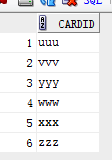
3)查询+去重+读者姓名等信息

with vt1 as
(select distinct cardid from borrow where to_char(to_date(borrowdate,'yyyy-mm-dd'),'yyyy')='2014'
and to_char(to_date(borrowdate,'yyyy-mm-dd'),'yyyy-mm')>='2014-02'
and to_char(to_date(borrowdate,'yyyy-mm-dd'),'yyyy-mm')<='2014-04')
select cardid, name,org from reader where exists (select cardid from vt1 where vt1.cardid=reader.cardid);

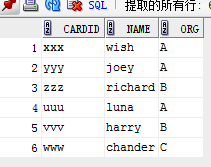
常见的ORACLE语句的更多相关文章
- [转载]T-SQL(Oracle)语句查询执行顺序
原文链接:http://blog.sina.com.cn/s/blog_61c006ea0100mlgq.html sql语法的分析是从右到左,where子句中的条件书写顺序,基本上对sql性能没有影 ...
- 性能测试常用Oracle语句
性能测试常用Oracle语句 显示数据库当前的连接数 select count(*) from v$process; 显示数据库最大连接数: select value from v$parameter ...
- oracle语句随笔
oracle语句随笔 dmp数据的导入. ; --创建用户 GRANT CONNECT,RESOURCE,DBA TO memsspc; --赋值权限 --cmd 中导入命令 IMP memsspc@ ...
- 53个Oracle语句优化规则详解(转)
Oracle sql 性能优化调整 1. 选用适合的ORACLE优化器 ORACLE的优化器共有3种:a. RULE (基于规则) b. COST (基于成本) c. CHOOSE ...
- Oracle语句优化1
Oracle语句优化1 优化就是选择最有效的方法来执行SQL语句.Oracle优化器选择它认为最有效的 方法来执行SQL语句. 1. IS NULL和IS NOT ...
- 常见的if语句shell脚本
常见的if语句shell脚本 author :headsen chen 2017-10-17 15:00:07 1,cat if.sh 2, cat if2.sh
- oracle语句insert into select如何加后续插入条件
oracle语句insert into select如何加后续插入条件 2014-01-21 10:48匿名 分类:其他编程语言 | 浏览 2746 次 oracle中有批量插入语句insert i ...
- Oracle 语句中“||”代表什么啊?
Oracle 语句中“||”代表什么啊? Oracle 语句中“||”代表什么啊?跟ServerSQL中的字符串的连接符“+”是一个概念么? 1. 恩是的 是一个含义...select '1'||'2 ...
- Oracle语句中IN和=的区别有哪些?
Oracle语句中IN和=的区别有: 1.首先应用范围不一样:in 可以理解为是范围内的选择:= 只有一个.例如: select sno, sname from t1 where sno in ('s ...
随机推荐
- 【python003-变量】
变量 一.在使用变量之前,需要先对其进行赋值 二.变量命名的规则:可以包含字母,数字,下划线,但是不能以数字开头 三.字符串: 1.引号内的一切东西 2.python的字符串是要在两边加上引号,对于单 ...
- django基础 -- 3. urls.py view.py 参数 别名 重定向 常用方法 静态文件
一.基本格式 from django.conf.urls import url from . import views #循环urlpatterns,找到对应的函数执行,匹配上一个路径就找到对应的函数 ...
- topcoder srm list
300 305 310 315 320 325 330 335 340 350 360 370 380 390 400 410 415 420 425 430 435 440 445 450 455 ...
- 《HTML与CSS 第一章 认识HTML》读书笔记
一.Web让广播明星黯然失色 要建立Web页面,需要创建用超文本标记语言(HyperText Markup Language,HTML)编写的文件,把它们放在一个Web服务器上 二.Web服务器能做什 ...
- lamp服务器被人恶意绑定域名的解决办法
还没开始就被别人绑定了域名 事情的起因与发现 刚买了个服务器搭建了一个dz,想着域名还没备案,就先搭建了起来,然后在做DDOS测试时偶然发现服务器被别人恶意把域名绑定了 最初的解决方案 没管..... ...
- (zhuan) 大牛讲堂 | 算法工程师入门第二期-穆黎森讲增强学习
大牛讲堂 | 算法工程师入门第二期-穆黎森讲增强学习 2017-07-13 HorizonRobotics
- Unity3D学习笔记(三十六):Shader着色器(3)- 光照
光照模型:用数学的方法模拟现实世界中的光照效果. 场景中模型身上的光反射到相机中的光线: 1.漫反射:产生明暗效果 2.高光反射:产生镜面反射,物体中有最亮且比较耀眼的一部分 3.自发光: 4.环 ...
- 【Hadoop 分布式部署 二:分布式环境预备工作(主机名 IP地址等设置)】
1.首先使用工具连接上 这三台虚拟主机 2.配置主机名 切换到 root 用户 第一种方式 可以使用命令 hostname [要更改的主机名] 但是这种更改主机名的方式 ...
- Derek解读Bytom源码-孤块管理
作者:Derek 简介 Github地址:https://github.com/Bytom/bytom Gitee地址:https://gitee.com/BytomBlockchain/bytom ...
- No mapping found for HTTP request with URI [/Portal/download] in DispatcherServlet with name 'springmvc'
本文为博主原创,未经允许不得转载: 遇到这个异常,总结一下这个问题发生的原因: 这个原因是在springmvc中在DispatcherServlet分发请求时,解析不到相应的请求路径.后台要请求的路径 ...
